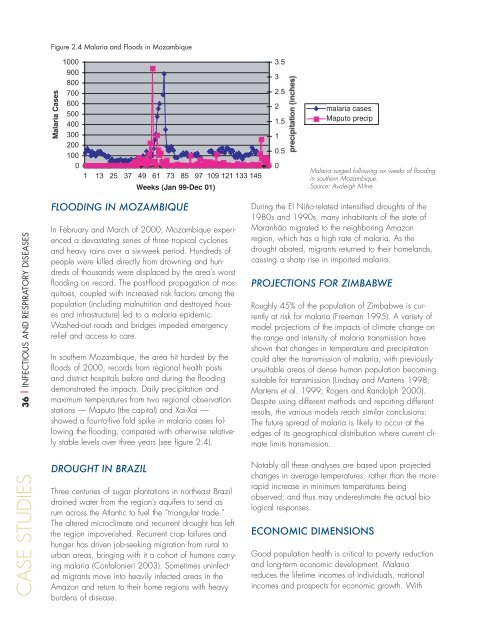Climate change futures: health, ecological and economic dimensions
Climate change futures: health, ecological and economic dimensions
Climate change futures: health, ecological and economic dimensions
You also want an ePaper? Increase the reach of your titles
YUMPU automatically turns print PDFs into web optimized ePapers that Google loves.
Figure 2.4 Malaria <strong>and</strong> Floods in Mozambique<br />
Malaria Cases<br />
1000<br />
900<br />
800<br />
700<br />
600<br />
500<br />
400<br />
300<br />
200<br />
100<br />
0<br />
1 13 25 37 49 61 73 85 97 109 121 133 145<br />
Weeks weeks (Jan99-Dec01)<br />
3.5<br />
3<br />
2.5<br />
2<br />
1.5<br />
1<br />
0.5<br />
0<br />
malaria cases<br />
Maputo maputo precip<br />
Malaria surged following six weeks of flooding<br />
in southern Mozambique.<br />
Source: Avaleigh Milne<br />
36 | INFECTIOUS AND RESPIRATORY DISEASES<br />
CASE STUDIES<br />
FLOODING IN MOZAMBIQUE<br />
In February <strong>and</strong> March of 2000, Mozambique experienced<br />
a devastating series of three tropical cyclones<br />
<strong>and</strong> heavy rains over a six-week period. Hundreds of<br />
people were killed directly from drowning <strong>and</strong> hundreds<br />
of thous<strong>and</strong>s were displaced by the area’s worst<br />
flooding on record. The post-flood propagation of mosquitoes,<br />
coupled with increased risk factors among the<br />
population (including malnutrition <strong>and</strong> destroyed houses<br />
<strong>and</strong> infrastructure) led to a malaria epidemic.<br />
Washed-out roads <strong>and</strong> bridges impeded emergency<br />
relief <strong>and</strong> access to care.<br />
In southern Mozambique, the area hit hardest by the<br />
floods of 2000, records from regional <strong>health</strong> posts<br />
<strong>and</strong> district hospitals before <strong>and</strong> during the flooding<br />
demonstrated the impacts. Daily precipitation <strong>and</strong><br />
maximum temperatures from two regional observation<br />
stations — Maputo (the capital) <strong>and</strong> Xai-Xai —<br />
showed a four-to-five fold spike in malaria cases following<br />
the flooding, compared with otherwise relatively<br />
stable levels over three years (see figure 2.4).<br />
DROUGHT IN BRAZIL<br />
Three centuries of sugar plantations in northeast Brazil<br />
drained water from the region’s aquifers to send as<br />
rum across the Atlantic to fuel the “triangular trade.”<br />
The altered microclimate <strong>and</strong> recurrent drought has left<br />
the region impoverished. Recurrent crop failures <strong>and</strong><br />
hunger has driven job-seeking migration from rural to<br />
urban areas, bringing with it a cohort of humans carrying<br />
malaria (Confalonieri 2003). Sometimes uninfected<br />
migrants move into heavily infected areas in the<br />
Amazon <strong>and</strong> return to their home regions with heavy<br />
burdens of disease.<br />
During the El Niño-related intensified droughts of the<br />
1980s <strong>and</strong> 1990s, many inhabitants of the state of<br />
Maranhão migrated to the neighboring Amazon<br />
region, which has a high rate of malaria. As the<br />
drought abated, migrants returned to their homel<strong>and</strong>s,<br />
causing a sharp rise in imported malaria.<br />
PROJECTIONS FOR ZIMBABWE<br />
Roughly 45% of the population of Zimbabwe is currently<br />
at risk for malaria (Freeman 1995). A variety of<br />
model projections of the impacts of climate <strong>change</strong> on<br />
the range <strong>and</strong> intensity of malaria transmission have<br />
shown that <strong>change</strong>s in temperature <strong>and</strong> precipitation<br />
could alter the transmission of malaria, with previously<br />
unsuitable areas of dense human population becoming<br />
suitable for transmission (Lindsay <strong>and</strong> Martens 1998;<br />
Martens et al. 1999; Rogers <strong>and</strong> R<strong>and</strong>olph 2000).<br />
Despite using different methods <strong>and</strong> reporting different<br />
results, the various models reach similar conclusions:<br />
The future spread of malaria is likely to occur at the<br />
edges of its geographical distribution where current climate<br />
limits transmission.<br />
Notably all these analyses are based upon projected<br />
<strong>change</strong>s in average temperatures, rather than the more<br />
rapid increase in minimum temperatures being<br />
observed; <strong>and</strong> thus may underestimate the actual biological<br />
responses.<br />
ECONOMIC DIMENSIONS<br />
Good population <strong>health</strong> is critical to poverty reduction<br />
<strong>and</strong> long-term <strong>economic</strong> development. Malaria<br />
reduces the lifetime incomes of individuals, national<br />
incomes <strong>and</strong> prospects for <strong>economic</strong> growth. With

















